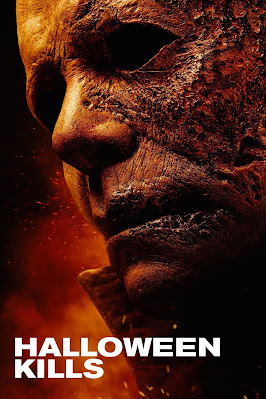Director: David Gordon Green
Notable Cast: Jamie Lee Curtis, Judy Greer, Andi
Matichak, James Jude Courtney, Nick Castle, Will Patton, Thomas Mann, Dylan Arnold,
Robert Longstreet, Anthony Michael Hall, Charles Cyphers, Kyle Richards
The revitalization of the Halloween franchise with
2018’s self-titled sequel, one that ignores every other film post the 1978
originator, is one for the history books. It reset the already over-complicated
franchise to go back to the roots but it still managed to progress the lore
forward in its own ways and inject a bit of social commentary that hit a lot of
the right buttons. Its massive success in the box office and a strong love from
the overall horror community made it ripe for reigniting one of the archetypal
slasher franchises. It wasn’t a shock that Blumhouse was quick to capitalize on
its success by announcing a sequel.
However, it was tempting fate that they would announce two
sequels to cap off the trilogy...a trilogy of four films, for the record, if
you count the 1978 original. Still, it was hard not to get expectations up
considering the strength of Halloween (2018), and a title like Halloween
Kills does sound pretty legit and stroked the excitement of my inner
teenager.
With a half-melted ghostly mask in tow, Michael Myers once
again stalks the silver screen with Halloween Kills and returning
director David Gordon Green (along with some returning writers a slew of other
filmmakers) aim to jack up the body count and set up a finale with the upcoming
Halloween Ends that will bring his portion of the franchise to an end.
The results are, in a fitting twist, incredibly problematic in their
ambitions.
With a story that immediately follows the fiery final set
piece of Halloween (2018), Halloween Kills immediately throws its
audience back into the foray. Well, kind of. How the film is initially
introduced is through some significant flashbacks to 1978. It’s a stark
reminder that making a film that is set minutes after the previous entry can be
problematic in pacing and Halloween Kills does suffer from those
choices. The significant backing stories, including more substance for police
officer Hawkins from 1978 and a modern story where Tommy (now played by Anthony
Michael Hall in the best performance in the film) incites a mob to hunt down
Myers feel like fluff and don’t necessarily constitute the character arcs or
plot progressions one might expect. It’s not that any single one is a misfire,
but most of these secondary plots do beg the question “why is this here, and
how does it serve the film?”
With the additional characters, which also include a couple
living in the Myers house and a few other local townsfolk with connections to
Myers’ 70s tirade, the film makes the relatively perplexing choice to mostly
sideline the three women who made the previous one such a delight to watch.
Jamie Lee Curtis’ Laurie Strode is sidelined for most of the film to make some
monologues in the strangest decision of the story and her daughter and
granddaughter are involved in mob plot to be lost in the foray. While it’s not unusual
for the film to not want to repeat the same messages and themes of the last
film, these choices undercut so much of the potential as a sequel and the new
messages and themes are not executed well enough to carry the weight of the
increased ensemble cast.
I do want to make this point clear concerning the script.
All of these scripting, character, dialogue, and plot issues that arise in this
film may be fixed with Halloween Ends. If anything, Halloween Kills
is plagued by “this is half of a two-part story” syndrome that is such an
affliction in modern cinema. Even the manner that the film ends, feels like it
should have been capped off with screen text that reads “To Be Continued…” It’s
irritating that they wouldn’t just want to make a film that stands on its own,
but that’s what Halloween Kills feels like and it makes the writing feel
unfinished, meandering, and like David Gordon Green and his co-writers
(including Danny McBride) were splitting their original story into two and
needed a lot more padding to fill out 105 minutes. It’s a problem and it
affects all aspects of this film.
With that said, Halloween Kills still has some
entertainment value to it. As mentioned, there are a handful of solid
performances and visually speaking Green is still harnessing that 70s
exploitation meets modern artsy vibe that stands out with a pop. The kill
sequences, of which there is an unsurmountable volume, are a lot of fun and
invoke those slasher vibes that horror fans are likely to devour with fervor.
The gore is plentiful and the film is having a lot of fun in building those
kill sequences. The initial slaughter, kick-started with a team of firefighters
that meet Evil, is a visual feast. Quite a few of them do reference the 1978
film, so those kinds of fan service can be distracting, but it does weave into
the film with relative ease.
If an audience wants to go in just to watch the
surface-level version of Halloween Kills, then it works. It delivers as
a hard-hitting slasher brimming with ultra-violent kills and some strong
atmosphere around Myers that delivers the horror thrills. It’s when the film
tries to layer in messages about misguided mobs that it tends to falter. The
additional plotting feels like padding and sideling Laurie is wildly
perplexing. As the first part of a two-part finale, maybe Halloween Kills
works, but that won’t come to light until Halloween Ends is unleashed.
As a stand-alone sequel, it tends to rely too much on an unfinished script to
truly be an effective film beyond the slasher.
For a film with a motiveless killer made of pure evil, maybe
it is fitting that this film feels a bit hollow empty.



No comments:
Post a Comment